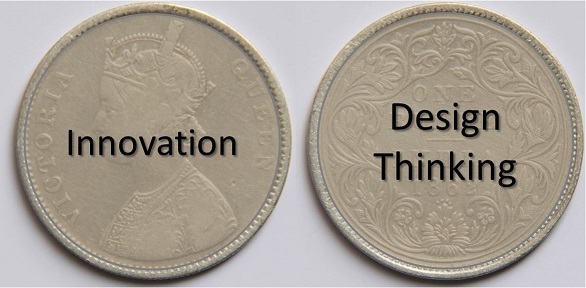Design-thinking and innovation are two different sides of the same coin (For those who have seen the Hindi film ‘Sholay’ would remember the coin used by Amitabh Bachchan that had same sides!) The two are different are inseparable. Innovation has always been understood as an outcome or an end and I too believe the same. Innovation is not a process. Leaders and managers have always desired to have a process that would result in innovations. No one has ever been able to define the means to achieve Innovation. If it was simple to define, every company would have followed it to become innovative. Design-thinking has partly been able to achieve this.
Wikipedia defined Design-thinking as: ‘Design-thinking in business uses the designer’s sensibility and methods to match people’s needs with what is technologically feasible and what a viable business strategy can convert into customer value and market opportunity’. It further says: Design-thinking has two common interpretations in the business world:
- Designers bringing their methods into business by either taking part themselves in business process, or training business people to use design methods
- Designers achieving innovative outputs or products
There can never ever be a process to identify and select an innovative idea that would turn out to be a very successful innovation. Can there be a process to know in advance the number of the lottery ticket that would win the jackpot or can there be a process to identify the horse/jockey that would win the race? There are ways and means that could improve the chances of success. This is the reason why innovation is best managed as a portfolio.
Regardless of the ideas that are selected by the management team for investment, the ability to implement the ideas with agility contributes most in differentiating two companies on their innovativeness. The execution teams could achieve any of the three states in the given time:
- They achieve less than what was visualized at the beginning resulting in significantly lowering the chances of commercial success. There are exceptional situations though.
- They achieve exactly what was visualized at the beginning thereby increasing the chances that the outcome would lack a few emerging attributes and may not meet the new desires of the customers. In such cases there are high chances that the outcome would be superseded by a competitor very soon. This is not always true and there are situations in which this may not happen.
- The teams apply design-thinking tools not only at the beginning but also during the implementation journey to ensure that the outcome is effective and long lasting. The fact is that to meet the customers’ needs the end outcome keeps changing and the teams not only keep track of these but also accommodate them in their development even faster. Pablo Picasso said, “I begin with an idea and then it becomes something else” and Fred Rogers said, “Often when you think you are at the end of something, you are at the beginning of something else”
I have often seen trainers of Design-thinking engaging the participants by making them actually construct a product by following a step by step process. The 7 Design-thinking tools suggested by Jeanne M. Liedtka and Timothy Ogilvie given below precisely help in achieving the end state explained in point # 3 above.
- Visualization
- Journey mapping
- Value chain analysis
- Mind mapping
- Rapid concept development
- Assumption testing
- Rapid prototyping
- Customer co-creation
- Learning launches
- Storytelling
Let us evaluate a few situations in which design-thinking would work and also a few other situations in which it won’t work.
| Situations in which Design-thinking would help
(How do I best achieve my dream innovation?) |
Situations in which Design-thinking will have limitations
(Which should be my next innovation? Which new technology shall I develop?) |
| If we have a product or a service and we wish to think of new ways to differentiate it with others (make it more innovative) or solve a problem related to the product – design-thinking would be able to help generate new ideas and also nudge you to select a few and implement them.
Example: A company that makes watches can use design-thinking to decide the features of its future watch targeted towards a specific set of customers. |
If we have to expand our product portfolio and venture into unrelated areas, design-thinking would not be able to provide promising results. Example: If the same watch company wishes to move into some other unrelated consumer product. |
| If we have a broadly defined end product/process, use of design-thinking would be useful in generating options and giving a firm and final shape to the product or the process and also ensure that the outcome is more robust and future ready.
If the same watch company decides to get into Jewellery business, design-thinking would be very useful to work out the details of various aspects of the business – retail space, supply chain, product range, shop floor design, supply chain etc |
If the new product is pre-dominantly dependent on development of a new technology, design-thinking will not help much. But once the company is confident of developing the technology, design-thinking could contribute a lot to ensure that the product delivers the best possible experience to the customer in it full lifecycle. |
| Design-thinking is usually very useful for near-term innovations. | Design-thinking may not deliver outcomes that could help in defining a long tem innovation roadmap/strategy |
If we continue with the example of luggage that I discussed in one of my earlier posts and if we apply design-thinking tools to the current luggage, I am sure we will find many interesting ideas that will make our need far less stressful and more enjoyable. We just need to apply design-thinking to the end goal of ‘people want their personal stuff wherever they travel’
References:

